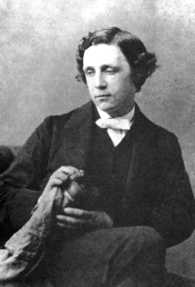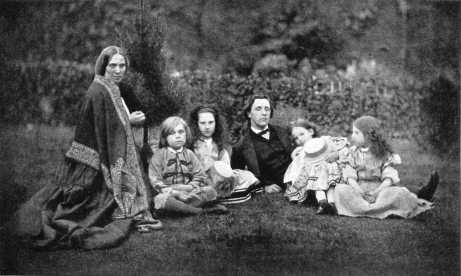
Lewis Carroll
(My complete GMD bio/commentary
is here).
Bibliography
Charles Dodgson, better known by his penname--Lewis Carroll,
became well acquainted with the MacDonald family starting
in 1862, having first met Greville and one of his older
sisters at the studio of the famous sculptor Alexander
Munro. Greville was a handsome young boy (about five or
six at the time) and Munro had asked him to be his model
for a statue that was to become part of a water fountain at
Hyde Park Corner in London. The statue for the fountain is
perhaps the oddest thing Munro ever sculpted, called
"Boy with Dolphin", the boy looking sweet, almost
angelic, but the dolphin looking monstrously  unnatural
and purposely so. The dolphin is missing the characteristic
top-fin that dolphins are known for and has a body more
like a serpent than a fish. One can only guess that Munro
might have been trying to portray a sense of what a dolphin
might have looked like in Fairyland with a head like an
ogre or a troll to some extent. Munro four years earlier
had modeled a medallion of George MacDonald's head, copied casts
of which hang in the National Portrait Gallery in
Edinburgh, and at King's College, Aberdeen respectively.
Munro would eventually introduce George MacDonald
unnatural
and purposely so. The dolphin is missing the characteristic
top-fin that dolphins are known for and has a body more
like a serpent than a fish. One can only guess that Munro
might have been trying to portray a sense of what a dolphin
might have looked like in Fairyland with a head like an
ogre or a troll to some extent. Munro four years earlier
had modeled a medallion of George MacDonald's head, copied casts
of which hang in the National Portrait Gallery in
Edinburgh, and at King's College, Aberdeen respectively.
Munro would eventually introduce George MacDonald to several new friends over the years. Perhaps the most
important to MacDonald's literary life was Arthur Hughes,
the artist who would go on to illustrate several of his
children's stories such as At the Back of the
North Wind.
to several new friends over the years. Perhaps the most
important to MacDonald's literary life was Arthur Hughes,
the artist who would go on to illustrate several of his
children's stories such as At the Back of the
North Wind.
Carroll was of course the author of such well known children's classics as Alice's Adventures in Wonderland, Through the Looking Glass and What Alice Found There, Sylvie and Bruno, and The Hunting of the Snark. He was also an excellent mathematician and was part of the mathematics department at Oxford for most of his adult life. Curiously, the books he wrote concerning mathematics he would have published under his real name. One may conjecture that he simply liked keeping his professional life separate from his lucrative hobby of writing fiction almost entirely for children. Carroll not only got along nicely with the MacDonald children but with their parents as well. He was a regular guest at their home for many years, and when not having fun with their youngsters, he and George MacDonald would often talk of literature, metaphysics, and the spiritual life. He had already made the friendship of Ruskin several years earlier, and he, like George, would become an aficionado of F.D. Maurice.
Carroll wrote his first "Alice" story with his own illustrations in 1863 then called, Alice's Adventures Under Ground. He brought the fairytale to George MacDonald wanting his opinion on the story's merits. MacDonald instead decided that the best test of the story would be to have his wife read it to his own small children. The MacDonald tots thoroughly enjoyed the tale and the whole family then urged Carroll to try to have it published. At the time, the manuscript was approximately half the size we know it today, and it was George MacDonald who encouraged Carroll to lengthen it.
Lewis Carroll's brother, Wilfred Dodgson, taught George MacDonald's athletic daughter, Mary, to box. Mary seemed to be quite a favorite with Carroll and he wrote many letters to her over the years. He also named a cat in his Through the Looking Glass story after Mary's real life cat--Snowdrop.
Carroll was of course an avid photographer. He photographed all eleven of the MacDonald children, although not all of the photos seem to have been preserved. Here he is in a photograph himself along with Louisa MacDonald and four of the MacDonald children:
Carroll's father was a minister in the Anglican Church, and he brought his son up to be a minister as well. Carroll had all the schooling and preparation needed to be an ordained clergyman but turned down the call. It's very difficult to ascertain why he did so. Greville MacDonald tells us that he believes it was Carroll's stuttering problem that kept him from refusing the ordination. At any rate, Lewis Carroll was a deeply religious man, though not a "high church" Anglican like his father. Like so many of MacDonald's friends, he had a great attraction to the mystical life and at least had a passing interest in Theosophy and Spiritualism in general. In one of his final books he sketches out the preparations for entering the world of Fairy in a paragraph that reads like a mystical text book. From Lewis Carroll's book: Sylvie and Bruno:
The next question is, what is the best time for seeing Fairies?
I believe I can tell you all about that.
The first rule is, that it must be a very hot day—that we may consider as settled: and you must be just a little sleepy—but not too sleepy to keep your eyes open, mind. Well, and you ought to feel a little—what one may call "fairyish "—the Scotch call it "eerie," and perhaps that's a prettier word; if you don't know what it means, I'm afraid I can hardly explain it; you must wait till you meet a Fairy, and then you'll know.
Lewis Carroll's biographers, like so many 20th century scholars, managed to see things that weren't there in his personal life related to his affiliations with children. Some of this is addressed in the full biography text of this website.
